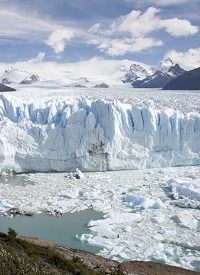
On the heels of the pronouncement by one of the gurus of global warming that any decrease in the earth’s temperature could be a thousand years away, another scientist has stepped forward with the warning that a new Ice Age could be right around the corner.
Professor Tim Flannery, the head of Australia’s Climate Change Commission, sparked the latest scandal in the global warming community when he recently declared, “If the world as a whole cut all emissions tomorrow, the average temperature of the planet’s not going to drop for several hundred years, perhaps over 1000 years.” As reported previously for The New American, Prof. Flannery has endeavored to ameliorate the effects of his comment by claiming that temperatures would begin to drop by the end of the century, but his millenarian prognostications served to highlight the ineffectiveness — even insignificance — of the proposed draconian reductions in the world’s industrial activity.
However, if George Kukla is correct, the cooling which Flannery and his cohorts desire may be coming in spades. Kukla, a retired professor of paleoclimatology at Columbia University, believes the Earth is no overdue for an Ice Age. An article by Terrence Aym (“Prepare for new Ice Age now says top paleoclimatologist”) at Helium.com sets forth some of Kukla’s argument:
The “Earth has experienced an ongoing cycle of ice ages dating back millions of years. Cold, glacial periods affecting the polar to mid-latitudes persist for about 100,000 years, punctuated by briefer, warmer periods called interglacials,” Kukla says.
Co-author of an important section of the book “Natural Climate Variability on Decade to Century Time Scales,” Kukla asserts all Ice Ages strat [sic] with a period of global warming. They are the the harbingers of new Ice Ages. Actually, he explains, warming is good. Ice Ages are deadly and may even kill millions.
Can Mankind stop it? No. Just as humanity cannot affect the long term climate of the planet, neither can it stop an Ice Age from happening. The climate is primarly [sic] driven by the sun.
Kukla has been warning of the possibility of new Ice Age for some time, and the cycle which he and other scientists believe may drive the process of climate change has been observed since at least the 1920s. Eleven years ago, Kukla gave a brief summary of his view on the cause of climate change for an article published by the Columbia University News:
In fact, the geologic record reveals that Earth has experienced an ongoing cycle of ice ages dating back millions of years. Cold, glacial periods affecting the polar to mid-latitudes persist for about 100,000 years, punctuated by briefer, warmer periods called interglacials. The Holocene is just another interglacial that is more than half over, Kukla said.
It turns out that this ongoing cycle of glaciation closely matches cyclic variations in Earth’s orbit around the sun, leading many researchers to conclude that orbit drives glaciation. This correspondence between orbit and climate is called the Milankovich cycle, after the scientist who analyzed and popularized it in the 1920s.
“I feel we’re on pretty solid ground in interpreting orbit around the sun as the primary driving force behind ice-age glaciation. The relationship is just too clear and consistent to allow reasonable doubt,” Kukla said. “It’s either that, or climate drives orbit, and that just doesn’t make sense.”
Kukla claims that 116,000 years have passed since the last Ice Age; therefore, if the theory is correct, Earth would be overdue for global cooling.
Of course, Kukla is not the only advocate of a theory of a new Ice Age; the difference between him and some very prominent promoters of the theory is that his model does not recognize any connection between such an event and human activity. Obama’s science ‘czar,’ John Holdren, coauthored a book with Paul Ehrlich in 1971 predicting that “global over-population was heading the Earth to a new ice age unless the government mandated urgent measures to control population, including the possibility of involuntary birth control measures such as forced sterilization.” Now, the doom and gloom crowd have completely reversed their assessment of the disaster which they claim will soon befall the human race, but the “solution” remains the same: Devastate the human species.
As the global warming theory has withered under public scrutiny in the aftermath of the Climategate and Glaciergate scandals, the theory’s proponents have been dashing around looking for a way to push their agenda. Last year, Holdren tried to adjust the language of the climate change debate by promoting a new terminology of “global climate disruption.” The cultivated ambiguity of Holdren’s new phraseology permits virtually any anomalous weather activity to constitute “proof” of their theory—rendering the theory incapable of being falsified, which is usually a fine indicator of pseudoscience.
Thus, Kukla’s theory of a new Ice Age is utterly different from the Holdren/Ehrlich’s “new Ice Age” of the 1970s, or the “global warming” scare which has predominated in the circles of scientific apocalypticism in recent decades. If Kukla is right, the Ice Age will come according to its own schedule, and there’s nothing that the human race can do about it—except, of course, for enjoying the brief warming that precedes the big chill.


